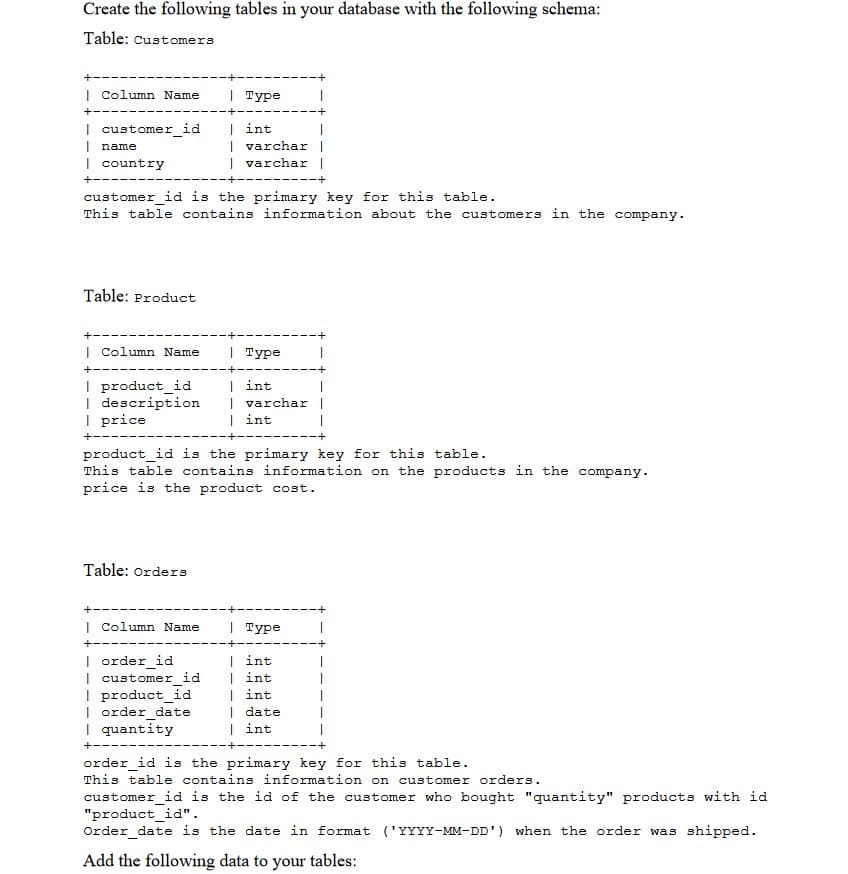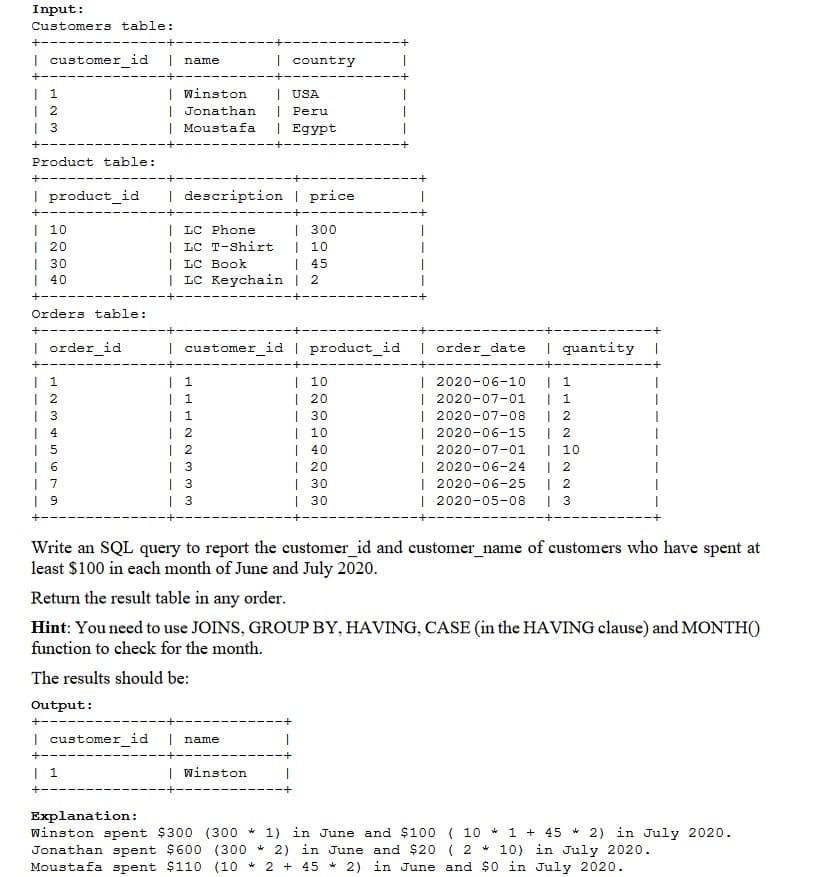Create the following tables in your database with the following schema: Table: customers | Column Name | Туре I customer_id I name | country I int | varchar | | varchar | +-- ---- customer_id is the primary key for this table. This table contains information about the customers in the company. Table: Product | Column Name 1 Туре I product_id I description I price | int I varchar | | int +- product_id is the primary key for this table. This table contains information on the products in the company. price is the product cost. Table: orders | Column Name 1 Туре | order_id | customer_id I product_id I order_date I quantity | int | int | int I date | int order_id is the primary key for this table. This table contains information on customer orders. customer_id is the id of the customer who bought "quantity" products with id "product_id". Order_date is the date in format ('YYYY-MM-DD') when the order was shipped.
Create the following tables in your database with the following schema: Table: customers | Column Name | Туре I customer_id I name | country I int | varchar | | varchar | +-- ---- customer_id is the primary key for this table. This table contains information about the customers in the company. Table: Product | Column Name 1 Туре I product_id I description I price | int I varchar | | int +- product_id is the primary key for this table. This table contains information on the products in the company. price is the product cost. Table: orders | Column Name 1 Туре | order_id | customer_id I product_id I order_date I quantity | int | int | int I date | int order_id is the primary key for this table. This table contains information on customer orders. customer_id is the id of the customer who bought "quantity" products with id "product_id". Order_date is the date in format ('YYYY-MM-DD') when the order was shipped.
Chapter13: Views
Section: Chapter Questions
Problem 1MC
Related questions
Question
Show all the sql query codes and the output with it please

Transcribed Image Text:Create the following tables in your database with the following schema:
Table: customers
| Column Name
| Type
| int
| varchar |
| varchar |
| customer id
I name
| country
+-
------+
customer_id is the primary key for this table.
This table contains information about the customers in the company.
Table: Product
| Column Name
| Туре
I product_id
| description
I price
| int
| varchar |
| int
+----
---
------+
product_id is the primary key for this table.
This table contains information on the products in the company.
price is the product cost.
Table: Orders
+-
| Column Name
| Type
+-
| order id
| customer id
I product_id
| order date
I quantity
| int
| int
| int
date
| int
+---
---+
order id is the primary key for this table.
This table contains information on customer orders.
customer_id is the id of the customer who bought "quantity" products with id
"product_id".
Order date is the date in format ('YYYY-MM-DD') when the order was shipped.
Add the following data to your tables:

Transcribed Image Text:Input:
Customers table:
+-----
| customer id
| country
name
+-
| 1
| 2
| 3
| winston
| Jonathan
| Moustafa
| USA
| Peru
| Egypt
+-
Product table:
+-----
I product_id
| description | price
+-
| 10
| 20
| 30
| 40
| LC Phone
| LC T-Shirt
| LC Book
| LC Keychain | 2
| 300
| 10
| 45
+----
Orders table:
+-----
| order id
| customer_id | product_id | order_date
I quantity
+-
| 2020-06-10
| 2020-07-01
| 2020-07-08
| 2020-06-15
| 2020-07-01
| 2020-06-24
| 2020-06-25
| 2020-05-08
| 1
| 1
| 2
| 2
| 10
| 2
| 2
| 3
| 1
| 2
| 3
| 1
| 1
| 1
| 2
| 2
| 3
| 3
| 3
| 10
| 20
| 30
| 10
| 40
| 20
| 30
| 30
| 5
| 7
Write an SQL query to report the customer_id and customer_name of customers who have spent at
least $100 in each month of June and July 2020.
Return the result table in any order.
Hint: You need to use JOINS, GROUP BY, HAVING, CASE (in the HAVING clause) and MONTH()
function to check for the month.
The results should be:
Output:
+-
| customer id
| name
+-
| 1
| winston
+-
Explanation:
winston spent $300 (300 * 1) in June and $100 ( 10 * 1 + 45 * 2) in July 2020.
Jonathan spent $600 (300 * 2) in June and $20 ( 2 * 10)
Moustafa spent $11o (10 * 2 + 45 * 2) in June and $0 in July 2020.
July 2020.
Expert Solution
This question has been solved!
Explore an expertly crafted, step-by-step solution for a thorough understanding of key concepts.
This is a popular solution!
Trending now
This is a popular solution!
Step by step
Solved in 2 steps

Follow-up Questions
Read through expert solutions to related follow-up questions below.
Follow-up Question
Where is the final sql query(select...) that is asked? could you write it
Solution
Knowledge Booster
Learn more about
Need a deep-dive on the concept behind this application? Look no further. Learn more about this topic, computer-science and related others by exploring similar questions and additional content below.Recommended textbooks for you


Database Systems: Design, Implementation, & Manag…
Computer Science
ISBN:
9781285196145
Author:
Steven, Steven Morris, Carlos Coronel, Carlos, Coronel, Carlos; Morris, Carlos Coronel and Steven Morris, Carlos Coronel; Steven Morris, Steven Morris; Carlos Coronel
Publisher:
Cengage Learning

Database Systems: Design, Implementation, & Manag…
Computer Science
ISBN:
9781305627482
Author:
Carlos Coronel, Steven Morris
Publisher:
Cengage Learning


Database Systems: Design, Implementation, & Manag…
Computer Science
ISBN:
9781285196145
Author:
Steven, Steven Morris, Carlos Coronel, Carlos, Coronel, Carlos; Morris, Carlos Coronel and Steven Morris, Carlos Coronel; Steven Morris, Steven Morris; Carlos Coronel
Publisher:
Cengage Learning

Database Systems: Design, Implementation, & Manag…
Computer Science
ISBN:
9781305627482
Author:
Carlos Coronel, Steven Morris
Publisher:
Cengage Learning